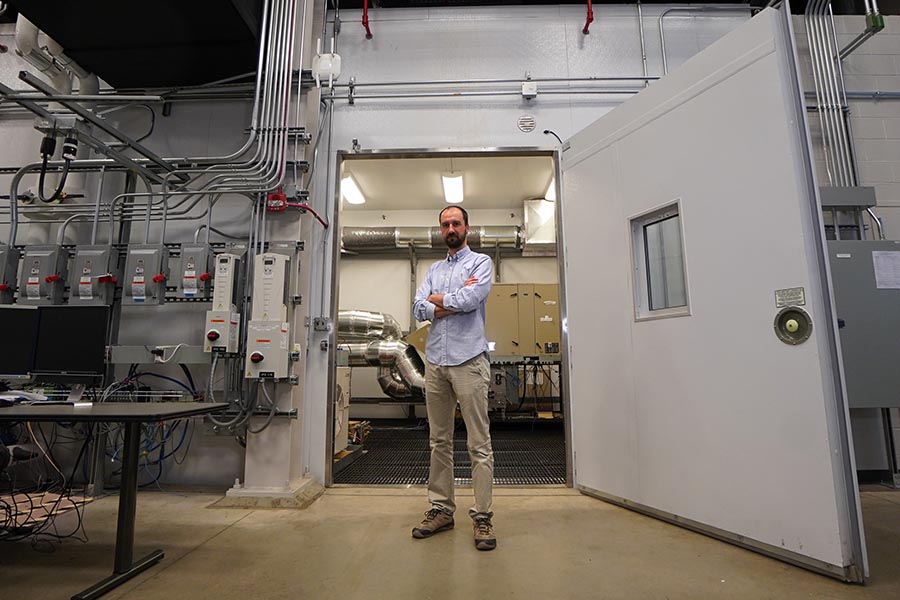Psychrometric chambers help to keep everyone cool
It may be winter outside, but at Herrick Labs — Purdue University's testbed for high performance buildings — they're running the air conditioners at full blast.
“Buildings use 40% of the country’s electricity,” said Orkan Kurtulus, a research engineer at Herrick Labs. “So testing this equipment is crucial to saving energy, and still ensuring that end users have comfortable homes and offices.”
Testing HVAC equipment (heating, ventilation, and air conditioning) requires a psychrometric chamber, a custom-built room that can create consistent conditions of temperature, humidity, pressure, and airflow. Herrick Labs operates six of these chambers, which are 13 1/2 feet wide, 19 1/2 feet long, and 9 1/2 feet tall.
“Psychrometric chambers come in pairs,” said Kurtulus. “An ‘outdoor’ chamber simulates the environment of the compressor and heat exchanger, which sit outside your home. Then an ‘indoor’ chamber duplicates the room-temperature environment inside your home. This way, we can re-create summer conditions to observe air conditioning equipment, or winter conditions to test which heating method is most efficient.”
The chambers are incredibly precise. They can maintain a constant environment within 0.5° C of their intended target, and 1% of their humidity target. They can also duplicate extreme conditions, from -20° C (-4° F) to 55° C (130° F), and from 15% to 100% humidity. That consistency is important, because researchers aren’t just monitoring the temperature of the air, but the refrigerants used to cool the air. “Refrigerant research is very important,” said Kurtulus. “We’re all working to find a refrigerant that is friendlier to the environment, but still efficient enough to do the job.”

Many traditional refrigerants have already been phased out in Europe, and likely will soon be phased out in the U.S. So the search is on for natural alternatives, such as propane (R290) or iso-butane (R600). Kurtulus and his team just completed an upgrade to one of the psychrometric chambers to enable testing of unitary equipment using natural refrigerants. They installed protected lighting and sensors, as well as grounding wire loops to allow technicians to work in the room while minimizing the chance of a stray spark.
Purdue joined with industry partners to complete these upgrades. UTC/Carrier provided funds to upgrade the chambers, while Parker Hannifin supplied temperature control equipment. “By doing their research here,” said Kurtulus, “our industry partners can create new and better technologies, and manufacture more efficient equipment. That saves both energy and money.”
Herrick Labs began in 1958, supported by a grant from Raymond Herrick, founder of the compressor manufacturer Tecumseh Products. In the fifty years since, it has become the largest academic HVAC lab in the world, with 124 graduate students and 27 faculty conducting research. Herrick also hosts conferences in compressors and refrigeration, welcoming 800 HVAC experts from more than 30 countries. Kurtulus also manages operations for the Center for High Performance Buildings, a multidisciplinary center established by a construction grant from the National Institute of Standards and Technology (NIST) to develop new building technologies to maximize energy usage, human comfort, and productivity.
“When it comes to thermal systems, Purdue is leading this research,” said Kurtulus. “Not just in the US, but worldwide.”
Writer: Jared Pike, 765-496-0374, jaredpike@purdue.edu
Source: Orkan Kurtulus, 765-494-1604, orkan@purdue.edu
